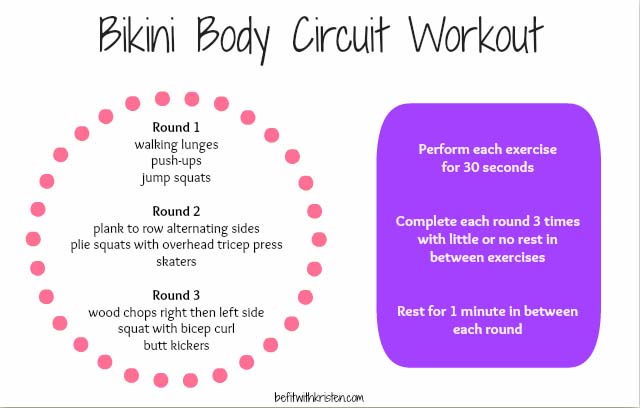March is the New January: Get a Bikini Body By June

Beach illustration via Shutterstock
Even with a monster snowstorm in March, warm weather will (hopefully) be here soon. In my experience as a personal trainer, it is clear that March is the new January when it comes to fitness. Though resolutions are often made during New Year’s, March is when people start to get serious about their summer bodies. Since the beginning of January I’ve received more than 100 leads from people looking to hire a personal trainer. The surprising part is that almost half came in over the last 30 days. It’s definitely crunch time.
If you have any hesitations about starting on your bikini body now consider this: It takes a solid 12 weeks of hard work and discipline to see a significant change in your body. That’s right, 12 weeks! It’s not an exact science, but generally this is what you can expect:
During the first four weeks your body is adapting to a new routine. You’re developing core strength and muscle coordination. Weeks four through eight you’ll notice improvements in overall muscle strength and endurance. Your body will start to look toned. At the end of eight weeks you have built up your stamina enough to push your workouts to the next level. After stepping it up, those last four weeks are all about burning more fat and calories and showing off the new you.
If you are feeling overwhelmed and looking for a place to start, follow this advice and you will be in that bikini before the end of June.
1. Ramp up the cardio.
Crunches will tone your abs, but cardio is what burns off the extra inches. Aim for at least 30 minutes of intense cardio three to four times per week. Running intervals on the treadmill are a great way to do this. Interval training consists of an intense bout of exercise followed by a period of rest.
Here is an example of a basic interval training workout. Scale it up or back according to your fitness level.
Warm up: 5 minute vigorous walk
Interval 1: 2 minutes at 5 mph, 2 minutes at 6 mph
Interval 2: 2 minutes at 5 mph, 2 minutes at 6.5 mph
Interval 3: 2 minutes at 5 mph, 2 minutes at 7 mph
Interval 4: 2 minutes at 5 mph, 2 minutes at 6.5 mph
Interval 5: 2 minutes at 5 mph, 2 minutes at 6 mph
Cool down: 5 minute walk
Total workout time: 30 minutes
Even if you aren’t a runner, 30 seconds of jogging followed by walking still has its benefits. It’s not what you do but how you do it that makes the difference.
2. Hit the weights.
Strength training is an important part of any weight loss program, especially if your are aiming to have a sculpted beach body. Try a full body circuit training routine. Circuit training is performing a series of exercises one after another with little or no rest in between. The advantage here is that you’ll be working on both muscular and cardiovascular endurance at the same time. The more muscle groups you hit with one circuit, the harder your body will work, and the better results you will achieve. To start, do everything in threes.
Three days a week (preferably on days you don’t do intense cardio) complete three full circuits of three different exercises. To keep the intensity level up, combine two strength exercises with one cardio intensive exercise. Try this workout to start and remember to change things up every four weeks:
Be sure to properly warm up before exercise and cool down afterwards to avoid injury. It is always a good idea to consult your primary care physician prior to starting a new exercise program, especially if you have an existing injury or health condition.
Chart descriptions:
Butt kickers: Stand on the balls of your feet and kick your heels up towards your butt, alternating your feet. Squeeze your hamstrings and glutes.
Skaters: Jump from side to side landing on one foot while swinging the arms with each jump. Keep your knees bent and the opposite leg off the ground as you land.
Wood chop: Start with your feet shoulder width apart holding a dumbbell or medicine ball in both hands. Engage your core as you squat and lower the weight towards your right foot. As you come back up to a standing position, lift the weight diagonally across your torso, up over the left shoulder. Keeping your arms straight as you cross your body is optimal. Repeat on the right for 15 seconds then switch to the left for 15 seconds. You should feel this in your core, especially your obliques.
Plank to row: Start in a plank position with each hand on a dumbbell. Lift your right arm up by your side in a bent position keeping it close to your body. Give a good squeeze behind your shoulder blade at the top of the motion and you’ll have some sexy back muscles to show off in your bikini. Alternate your sides.
3. Keep it fun and interesting.
Think outside of the box when it comes to your fitness routine. Go to the park to work out and instead of bicep curls at the gym, go for pull ups on the monkey bars. Or mix things up by running or walking backwards uphill. Not only will this get your heart beating and your hamstrings burning, it will nicely shape your derriere.
4. Think of your body as a machine.
Fuel it properly and you will see favorable results. As the saying goes, “abs were made in the kitchen” and that’s the truth. Though this may seem like common sense to many, some don’t put enough emphasis on nutrition. It’s a very important part of the equation. Cut back on sugar, saturated fats, processed foods, and, yes, alcohol too. Instead fuel it with healthier foods such as lean proteins, healthy fats, non- or minimally-processed carbs, and of course plenty of fruits and vegetables.
5. Challenge yourself.
If an exercise becomes easy, add more resistance, time, or exercises to your circuit. For example, you could add weight to your walking lunges or simply increase the duration from 30 to 60 seconds. If you are a real die hard combine all three circuits into one. This means no resting in between all nine exercises.
However you decide to break it up, make sure you are working at a high enough intensity to yield results. If you have a heart rate monitor, work between 65 percent and 85 percent of your maximum. If you don’t have a monitor then use your rate of perceived exertion. It works like this: On scale of one to 10, with one being that you could read a book and 10 meaning you are ready to keel over, you should consistently be between six and eight.
Have any questions about any of the exercises? Ask Kristen in the comments!



